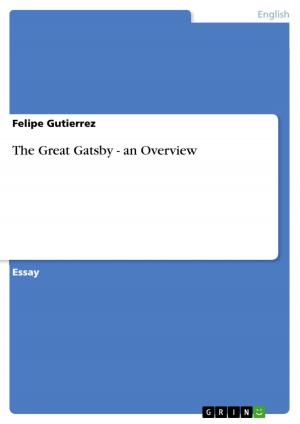How does Shakespeare utilise the sonnet form to express emotion? Discuss with reference to at least three poems
Fiction & Literature, Literary Theory & Criticism, British| Author: | Anne Thoma | ISBN: | 9783638283441 |
| Publisher: | GRIN Publishing | Publication: | June 16, 2004 |
| Imprint: | GRIN Publishing | Language: | English |
| Author: | Anne Thoma |
| ISBN: | 9783638283441 |
| Publisher: | GRIN Publishing |
| Publication: | June 16, 2004 |
| Imprint: | GRIN Publishing |
| Language: | English |
Seminar paper from the year 2004 in the subject English Language and Literature Studies - Literature, grade: 68 % (A-), University of Warwick, course: Medieval to Renaissance English Literature, 11 entries in the bibliography, language: English, abstract: In 'The Merchant of Venice', Shakespeare states an attitude towards form and matter which can be considered not only as that of the character but also as his own: Those 'that for a tricksy word defy the matter' are 'fools' (Hubler 243). This can be read as a claim that form must be subordinated to substance (Hubler 241). Indeed, with regard to the sonnets, Shakespeare does not seem to be very inventive as far as the form is concerned. He adopts the rhyme scheme that Surrey established (abab - cdcd - efefgg) (Spiller 158), draws on the highly passionate and rhetorical language formerly used by Sidney, and he employs some of Spenser's phrasings in his own works (Prince 176 and 178). Yet, there is something unique about Shakespeare's poetry, something which is not purely derived from the substance but t o a large extent from the structure. It is the conveyance of emotion with means that are part of the form. In a narrow sense, 'form' is 'that in virtue of which the parts are related one to another' (Nowottny 111). This notion focuses on elements in terms of their formal (arrangement of the lines into stanzas), syntactical, logical, and phonetic relationship towards each other and is mainly concerned with movements produced by those elements (Booth, 175). In a wider sense, 'form' as the opposite of 'contents' also includes the use of imagery and other devices which form part of the poetic technique. In the following essay, I will focus on the narrow concept of 'form' and explain why and how the sonnet provides a frame within which Shakespeare finds numerous tools to express emotion. After some outlining general remarks about the contents of Shakespeare's Sonnets and the topics best suited for this kind of poetry, I will deal with Sonnets 29, 4, and 23, all of which belong to the category associated with the young man. I will also point out how Shakespeare's use of the form differs from that of Sidney, exemplified through Sonnet 71 of the sequence Astrophil and Stella. I will conclude by saying that the form, even if Shakespeare did think it a vassal to the matter of the sonnet, is to a large extent responsible for the success that the poems have achieved in their attempt to convey the denseness of human emotion. [...]
Seminar paper from the year 2004 in the subject English Language and Literature Studies - Literature, grade: 68 % (A-), University of Warwick, course: Medieval to Renaissance English Literature, 11 entries in the bibliography, language: English, abstract: In 'The Merchant of Venice', Shakespeare states an attitude towards form and matter which can be considered not only as that of the character but also as his own: Those 'that for a tricksy word defy the matter' are 'fools' (Hubler 243). This can be read as a claim that form must be subordinated to substance (Hubler 241). Indeed, with regard to the sonnets, Shakespeare does not seem to be very inventive as far as the form is concerned. He adopts the rhyme scheme that Surrey established (abab - cdcd - efefgg) (Spiller 158), draws on the highly passionate and rhetorical language formerly used by Sidney, and he employs some of Spenser's phrasings in his own works (Prince 176 and 178). Yet, there is something unique about Shakespeare's poetry, something which is not purely derived from the substance but t o a large extent from the structure. It is the conveyance of emotion with means that are part of the form. In a narrow sense, 'form' is 'that in virtue of which the parts are related one to another' (Nowottny 111). This notion focuses on elements in terms of their formal (arrangement of the lines into stanzas), syntactical, logical, and phonetic relationship towards each other and is mainly concerned with movements produced by those elements (Booth, 175). In a wider sense, 'form' as the opposite of 'contents' also includes the use of imagery and other devices which form part of the poetic technique. In the following essay, I will focus on the narrow concept of 'form' and explain why and how the sonnet provides a frame within which Shakespeare finds numerous tools to express emotion. After some outlining general remarks about the contents of Shakespeare's Sonnets and the topics best suited for this kind of poetry, I will deal with Sonnets 29, 4, and 23, all of which belong to the category associated with the young man. I will also point out how Shakespeare's use of the form differs from that of Sidney, exemplified through Sonnet 71 of the sequence Astrophil and Stella. I will conclude by saying that the form, even if Shakespeare did think it a vassal to the matter of the sonnet, is to a large extent responsible for the success that the poems have achieved in their attempt to convey the denseness of human emotion. [...]















